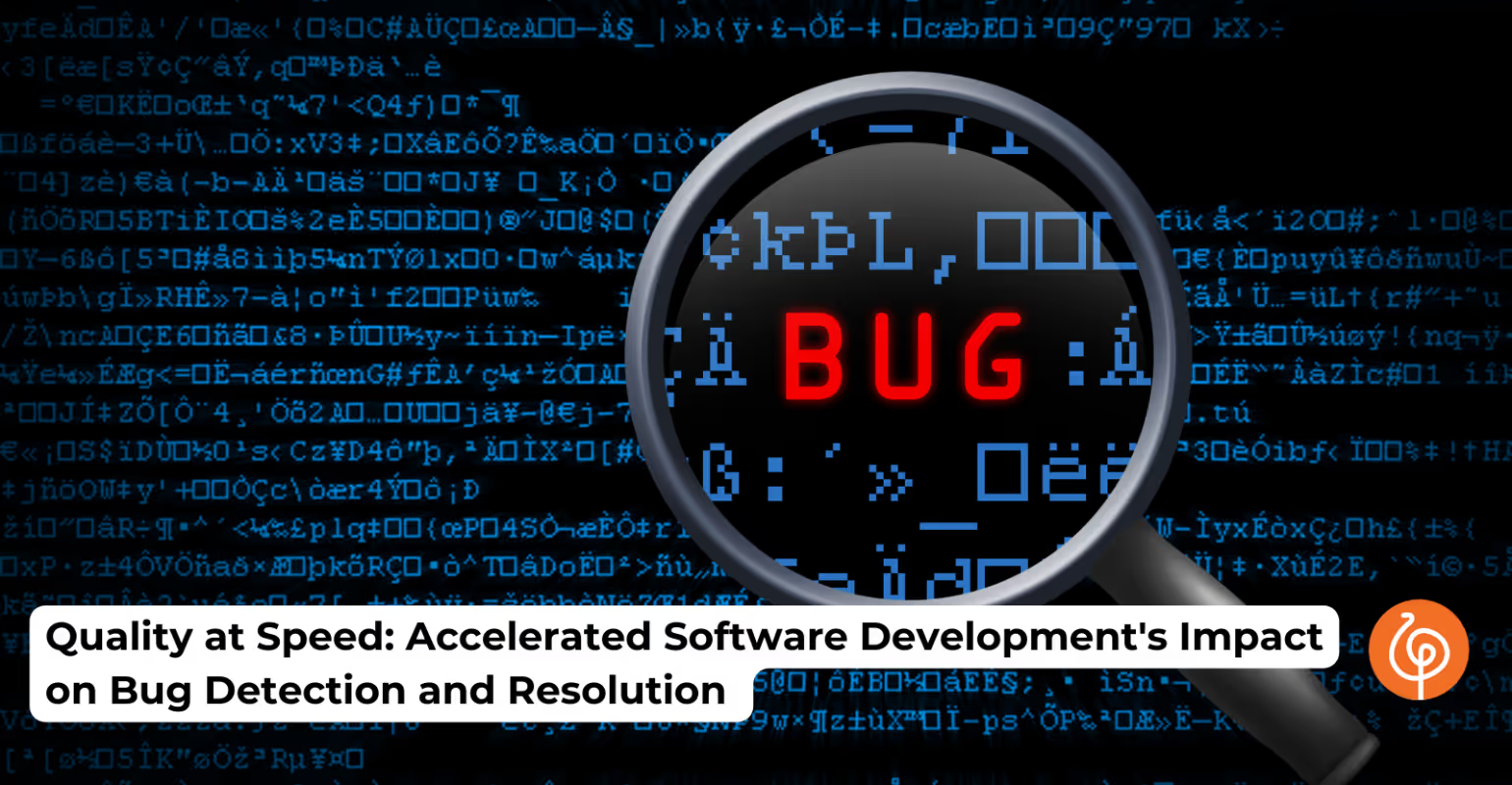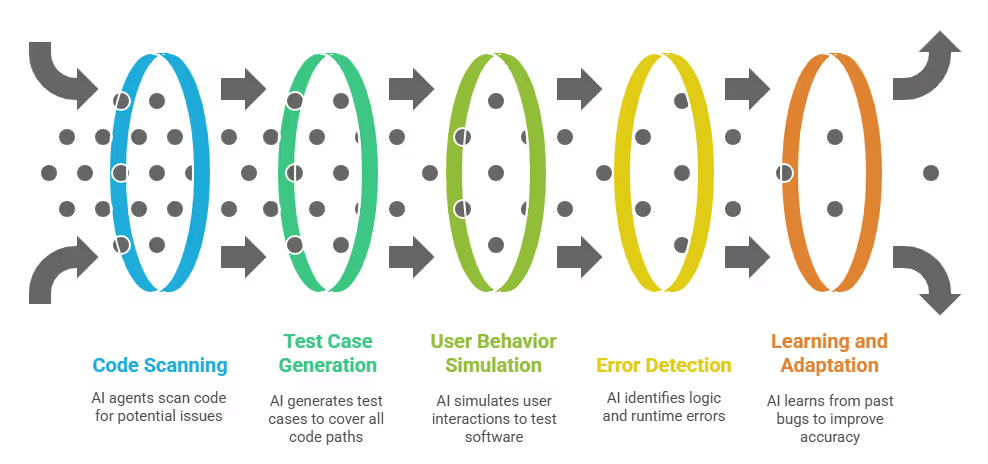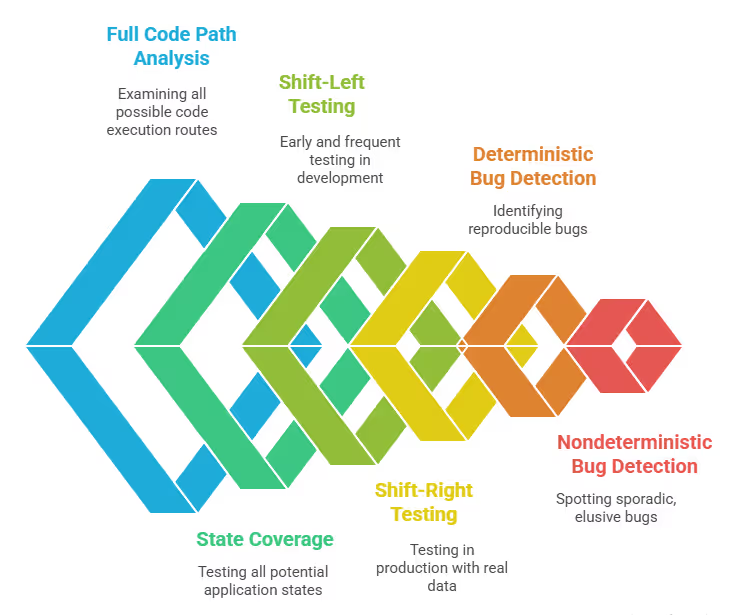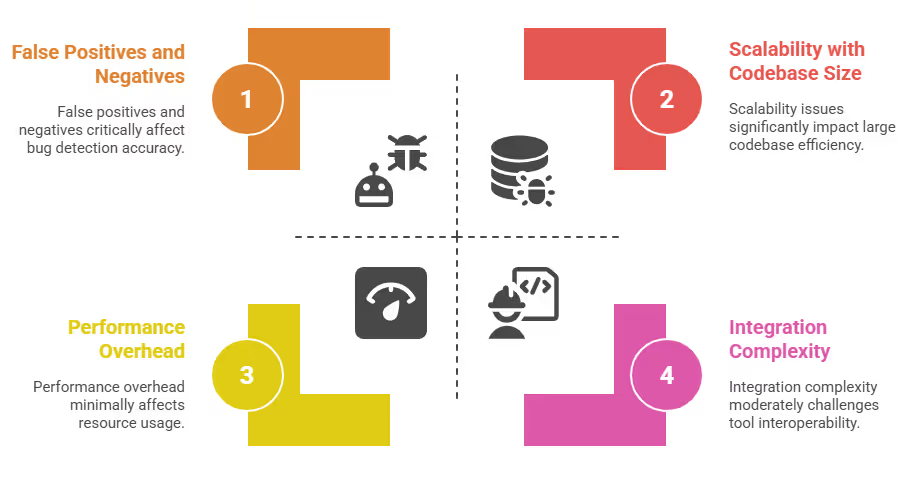Exhaustive Bug Detection using AI Agents | Tools, Benefits & Use Case

Exhaustive Bug Detection using AI Agents
What is Exhaustive Bug Detection using AI Agents?
Exhaustive bug detection using AI agents is the process of using artificial intelligence to automatically scan, test, and analyze software for all possible bugs, across every code path, input, and state. These AI agents simulate user behavior, generate test cases, detect logic and runtime errors, and learn from past bugs to improve accuracy. This approach helps teams catch hard-to-find issues early, reduce manual testing, and increase code reliability at scale.
Exhaustive bug detection using AI Agents use machine learning to analyze code, predict failures, and identify complex error patterns, significantly enhancing software quality and reducing debugging time.

Why Exhaustive Bug Detection using AI Agents Matters
The goal of implementing AI in QA is not to replace human testers but to augment their capabilities. A human-in-the-loop approach is crucial for success. AI agents can handle the tedious, repetitive tasks of regression testing and basic error detection, freeing up human testers to focus on more complex and creative aspects of quality assurance.
For instance, while an AI agent can execute thousands of test cases and analyze logs for anomalies, a human tester's expertise is invaluable for:
- Exploratory Testing: Using their intuition and experience to uncover unexpected bugs and usability issues that a scripted test might miss.
- User Experience (UX) Review: Evaluating the overall user flow, accessibility, and visual design—tasks that require human judgment and empathy.
- Defining Test Strategy: Designing comprehensive test plans, identifying critical user journeys, and prioritizing which areas of the application require the most scrutiny.
This collaboration creates a powerful synergy, where the AI provides speed and scale, and the human team provides strategic oversight and deep-level analysis. For many of our partners in India's booming SaaS sector, this hybrid model has proven to be the most effective for maintaining a high standard of quality without sacrificing agility.
Common Types of Software Bugs
To effectively detect bugs, you must first understand them. Bugs come in many forms, each requiring a different detection strategy.
- Logic Errors: These are bugs where the code runs without crashing, but the result is incorrect. An example would be an e-commerce platform that calculates a 10% discount incorrectly, applying it to the wrong price.
- Runtime Errors: These are bugs that cause the application to crash or behave unexpectedly while it's running. Think of a null pointer exception or a division by zero.
- Memory Leaks: A memory leak occurs when an application fails to release memory it no longer needs, leading to a gradual slowdown and eventual crash. These are particularly insidious and hard to spot.
- Security Vulnerabilities: These are flaws that can be exploited by malicious actors. Examples include SQL injection, Cross-Site Scripting (XSS), and unauthenticated API endpoints.
- UI/UX Bugs: These are issues that affect the user interface or experience, such as a button that doesn't work, misaligned text, or a form that fails to validate correctly.
Why Traditional Bug Detection Methods Fall Short
Traditional bug detection, often reliant on manual testing and simple automated scripts, is a reactive and inherently incomplete approach.
As a company specializing in product engineering, we've observed that this model is no longer sustainable for modern software.
- Incomplete Code Coverage: Manual and scripted tests typically follow "happy paths" or expected user flows. They often miss the nuanced, interconnected parts of the application, leaving a large portion of the codebase untested. This means obscure bugs, edge cases, and unexpected user actions are left to be discovered by the end-user, often in production.
- The Scale Problem: The sheer size and complexity of modern applications—think millions of lines of code, microservices, and third-party integrations—make exhaustive manual testing impossible. What might take a QA team weeks to test, a new feature can introduce a new set of bugs. The test suite is always playing catch-up, and the backlog of potential bugs grows continuously.
- Human Cognitive Bias: Human testers, while invaluable, are susceptible to cognitive biases. They may subconsciously follow the same test paths, overlook subtle visual inconsistencies, or fail to notice a non-critical error that could lead to a major issue down the line. Fatigue and repetition also lead to a higher likelihood of human error.
- Delayed Feedback: In a traditional waterfall or even a non-optimized agile model, testing is often a late-stage activity. Bugs found at this stage are much more expensive and time-consuming to fix than those found early in the development process. A small architectural flaw found during a final QA pass can derail a product launch.
Core Principles of Exhaustive Bug Detection
Exhaustive bug detection is a paradigm shift that demands a different set of principles.
It's a proactive, strategic approach that moves beyond simply finding bugs and focuses on preventing them.

- Full Code Path Analysis: This principle dictates that every single possible path a user or data can take through the code should be analyzed. This isn't just about functional flows; it's about checking every "if-else" statement, every loop, and every function call. Tools using AI and static analysis can now simulate and test a near-infinite number of code paths.
- State Coverage and Edge Case Handling: Modern applications have a massive number of potential states (e.g., a user's shopping cart with 0, 1, or 100 items; a subscription status that is active, expired, or pending). Exhaustive detection requires systematically testing all of these states and the transitions between them. This includes handling "edge cases" - inputs at the boundaries of what is expected, which are often the source of bugs.
- Shift-Left, Shift-Right: A modern, exhaustive strategy integrates testing into every phase. "Shifting left" means testing early and often, from design to code commit, to catch bugs when they're cheapest to fix. "Shifting right" means extending testing into the production environment, using real user data and monitoring to uncover issues that only appear under live, high-traffic conditions.
- Deterministic vs. Nondeterministic Behavior Detection: A deterministic bug is one that can be reliably reproduced. A nondeterministic bug, often called a "Heisenbug," only appears sporadically, making it incredibly difficult to track down. AI-powered monitoring and dynamic analysis are crucial for identifying these elusive bugs by observing thousands of system behaviors in real-time to spot subtle anomalies.
The Role of AI in Exhaustive Bug Detection
AI is not a magic bullet, but it is the key enabler for exhaustive bug detection. It amplifies human expertise and automates the most tedious and complex parts of the QA process.
- AI-Assisted Code Reviews: Tools like GitHub Copilot and other AI linters can analyze code as it's being written, flagging potential bugs, security vulnerabilities, or anti-patterns in real-time. This provides immediate, contextual feedback to developers, preventing issues from ever being committed to the main branch.
- Generative Testing Approaches: One of the most powerful applications of AI is its ability to create intelligent, unique test cases. By analyzing an application's design, user stories, and historical bug data, a generative AI can automatically create new test scenarios that a human might never have considered. This dramatically increases test coverage and finds bugs in unexpected places.
- Predictive Bug Analytics: AI can analyze vast datasets of past bugs, code commits, and developer activity to build predictive models. These models can then be used to forecast which parts of a new feature are most likely to have bugs. This allows QA teams to prioritize their efforts and focus their attention on the highest-risk areas, a critical capability for any AI agent development company.
- Intelligent Root Cause Analysis: When a bug is found, AI can sift through a mountain of logs, traces, and performance data in seconds to pinpoint the exact line of code or sequence of events that caused the failure. This drastically reduces the time a developer spends on debugging, allowing them to focus on fixing the problem rather than finding it.
How to Build a Exhaustive Bug Detection Pipeline using AI Agents
A bug detection pipeline is a series of automated checks and processes that ensure software quality at every step of development.

- Integrate Tools in CI/CD: The foundation of the pipeline is your Continuous Integration/Continuous Deployment (CI/CD) system. Every code push should automatically trigger a series of checks, including:
- Static Code Analysis: Linters, security scanners, and code quality tools run on every commit.
- Unit and Integration Tests: Automated tests for small code units and their interactions.
- Automated Regression Tests: A comprehensive suite of tests to ensure new changes haven't broken old functionality.
- Implement AI-Powered Monitoring: Deploy AI-driven observability tools in your staging and production environments. These tools continuously monitor application performance and behavior, using anomaly detection to alert teams to potential issues before they escalate.
- Prioritize Bug Severity: Not all bugs are equally important. Your bug tracking system must have a clear, agreed-upon framework for prioritizing bugs (e.g., Critical, High, Medium, Low). Bugs should be automatically triaged and routed to the correct team based on their severity and source.
- Establish a Feedback Loop: The pipeline should provide clear, actionable feedback to developers. When a test fails, the developer should immediately receive a notification with a link to the relevant code, a description of the issue, and a potential fix. This tight feedback loop is crucial for preventing the same bugs from being introduced multiple times.
Real-World Examples of Critical Bugs Caught Late
The history of technology is littered with examples of bugs that cost companies millions, caused massive security breaches, or even had catastrophic real-world consequences.
- The Therac-25 Radiation Machine (1980s): A software bug in a radiation therapy machine caused it to deliver lethal doses of radiation to patients, leading to several deaths. The bug was a classic race condition, a nondeterministic issue that was impossible to reproduce reliably in a controlled environment.
- The Mars Climate Orbiter (1999): The loss of a $125 million NASA satellite was traced back to a simple bug: a team of engineers used imperial units (pounds-force) while the software expected metric units (Newtons). This is a stark reminder of the importance of thorough integration testing, especially when different components are developed by different teams.
- The Equifax Data Breach (2017): A known vulnerability in an open-source framework was not patched, leading to a massive data breach that exposed the personal information of 147 million people. This highlights the critical need for continuous security monitoring and automated vulnerability scanning, which should be a core part of any robust bug detection pipeline.
Challenges in Exhaustive Bug Detection using AI Agents
While the benefits are clear, implementing an exhaustive bug detection strategy comes with its own set of challenges.

- False Positives and Negatives: Static analysis and AI tools can sometimes produce false positives (flagging an issue that isn't a bug) or false negatives (missing a real bug). This requires human oversight and a continuous process of refining the tools' configurations.
- Performance Overhead: Running a full suite of exhaustive tests on every code change can be resource-intensive and time-consuming. Finding the right balance between test coverage and speed is a constant challenge, requiring intelligent test prioritization and parallelization.
- Scalability with Codebase Size: As a codebase grows, the number of potential test cases and code paths grows exponentially. While AI helps, it's still a significant challenge to ensure your bug detection system can scale efficiently without becoming a bottleneck.
- Integration Complexity: Integrating a wide array of tools—from linters and static analyzers to AI-driven test platforms and monitoring solutions—can be a complex and time-consuming task that requires specialized expertise.
Best Practices for Developers and QA Teams
A successful bug detection strategy relies on a cultural shift and a collaborative effort between developers and QA.
- Test-Driven Development (TDD): TDD is a powerful practice where developers write tests before writing the code itself. This ensures that every piece of code has a corresponding test case, leading to higher quality and better code coverage from the start.
- Collaborative Code Reviews: Code reviews should not be a task to rush through. They should be a collaborative process where multiple developers and a QA representative review every change. This helps catch bugs and anti-patterns early and promotes knowledge sharing within the team.
- Treat QA as a Partner, Not a Gatekeeper: In a modern agile environment, the QA team is not a separate entity that simply "tests" the code. They are embedded within the development team, helping to define requirements, write test cases, and provide continuous feedback.
- Adopt a Bug Report Template: A standardized bug report template, whether created manually or with an AI-driven tool, ensures that all the necessary information is collected. The report should be clear, concise, and include steps to reproduce, expected behavior, and actual behavior.
Future of Bug Detection: Towards Full Automation
The future of bug detection is moving towards a fully automated, autonomous system.
- AI-Driven Autonomous Testing: In the coming years, we will see the rise of AI agents that can not only generate test cases but also autonomously explore an application, learn its intended behavior, and identify bugs without human intervention. These agents will be able to perform complex exploratory testing at a scale that is currently unimaginable.
- Zero-Bug Tolerance: As AI tools become more powerful, the industry will move towards a "zero-bug" mindset, where bugs are not an accepted part of the software development process. The focus will shift from finding and fixing bugs to preventing them from ever being written in the first place.
- The Rise of DevSecOps: Bug detection will be fully integrated with security and operations. Automated security scanning, vulnerability detection, and production monitoring will be a seamless part of the development lifecycle, ensuring that an application is not only bug-free but also secure and reliable.
Why Exhaustive Bug Detection Should Be Standard Practice
Exhaustive bug detection is no longer a luxury for a select few. It is a necessity for any company that wants to build reliable, high-quality software. From leveraging AI to conducting thorough code path analysis, this approach guarantees that your product is not just functional but resilient. By making this a standard practice, you can build trust with your customers, reduce technical debt, and ensure the long-term success of your products.
If your company is ready to move beyond reactive bug-fixing and build an exhaustive bug detection pipeline, contact us. As a leading web app development company, we can help you build the systems and implement the strategies needed to achieve a new level of software quality.

